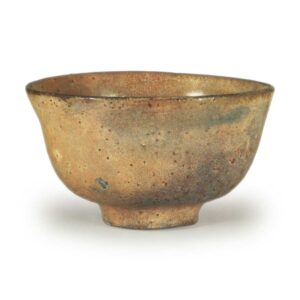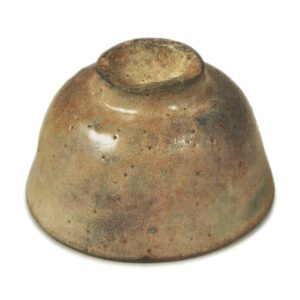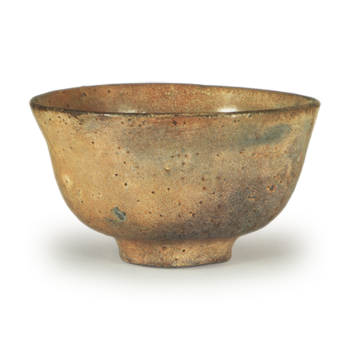

Height: 8.1 to 8.8 cm
Diameter: 14.3 to 15.2 cm
Outer diameter of foot ring: 5.8 to 6.0 cm
Height of foot ring: 1.3 cm
There are not many good Hagi ware tea bowls. The eighth volume of the Taisho Meiki Kan (A Guide to Famous Tea Bowls of the Taisho Period) includes three bowls by Korekai-bo, Tagonoura and Ganso Hagi, but they are all contrived and overly twisted. This tea bowl, which is called Hakuyu, is unusual for Hagi ware in that it is simple and yet has a deep charm.
The clay is a fine clay with a high iron content and a small amount of sand, and the entire inside and outside is covered in a white slip, and then a transparent glaze is applied on top. There are fine cracks all over the surface, and the cracks are slightly rough in places where the glaze is thick.
The shape has a slightly upturned rim, a plump waist, and a relatively high foot ring. The bottom is rounded off, there is no helmet cloth, and there are two marks inside the foot ring.
The inside is dented, and there are two circular marks around it. There are also shallow potter’s marks on the inside.
The firing was slightly reductive, and it has a light blue-grey color. The thickly glazed areas have a light purple color, probably due to the straw mixed in with the glaze. There are small air bubbles all over the body, and tea stains have seeped in through these holes, creating a pattern on the body that looks like rain leaking in. As a result, the body has a variety of complex colors, including light ink-black, light purple, bluish, and a small amount of loquat-colored areas.
This is a rare and excellent tea bowl that looks like a Korean tea bowl at first glance. It is a well-used tea bowl with a surface that is closer to that of a powder-coated bowl than a Hagi bowl, and its shape and foot ring are also unusual for a Hagi bowl.
The bowl is rather thick and solid, but it also has a certain elegant feel to it, and the name “Hakua” (white rain) was probably given because of this.
There are two gutters around the rim, and there are also a couple of small loose spots, which have been repaired with black lacquer, but they are not very noticeable.
It is thought to be from the early Edo period, but it is not possible to say exactly when it was made, and it is also not known whether it is a Matsumoto Hagi or a Fukagawa Hagi, so it is not clear who the artist was.
It is in a black lacquered box, and on the front of the lid is the inscription “Hakiya Iku Hakusui Chaen” in gold powder.



